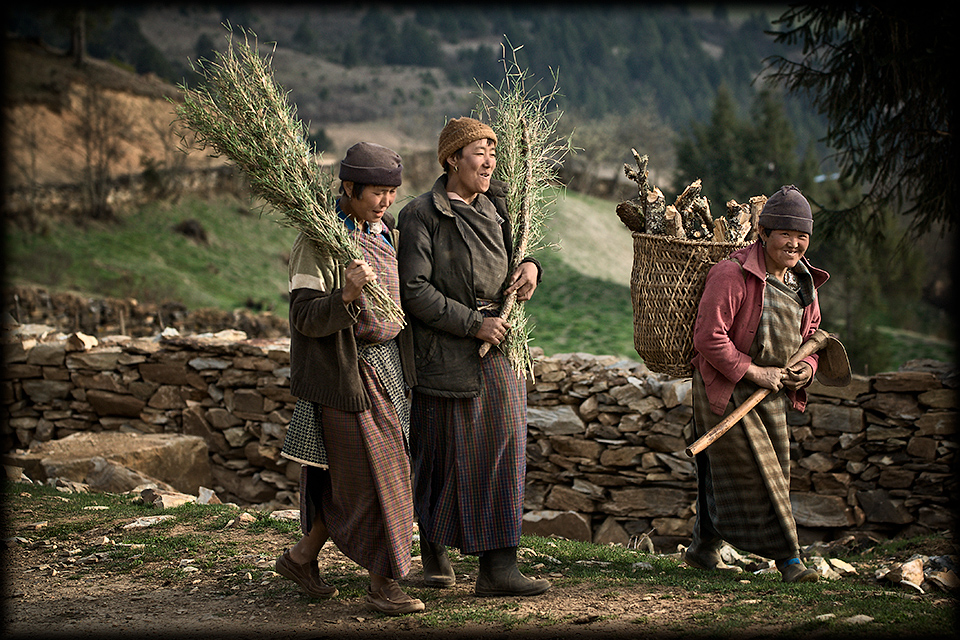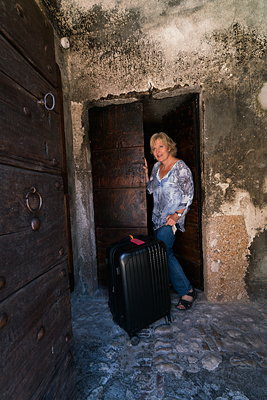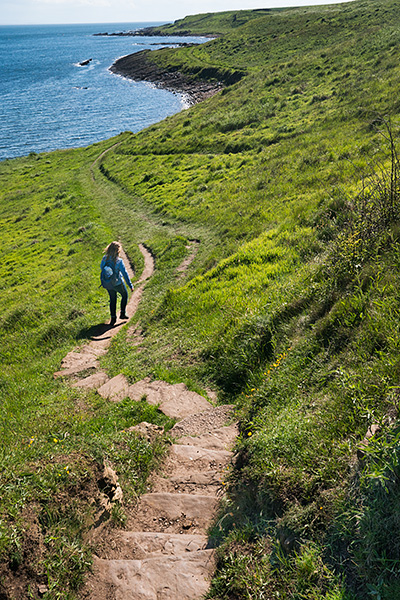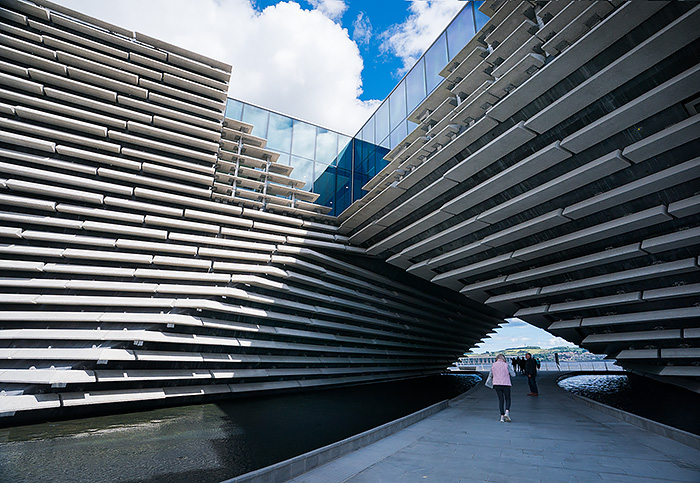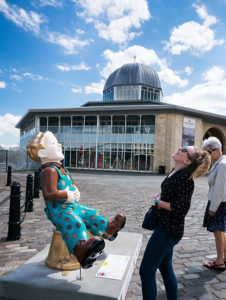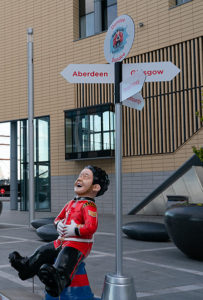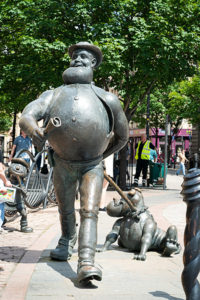
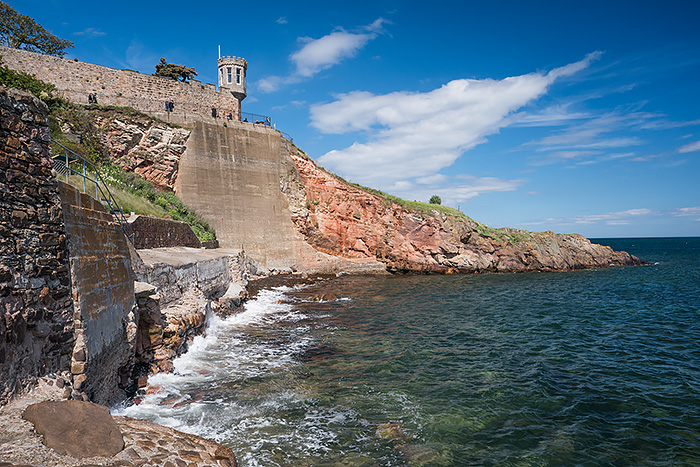
Crail coast
Part 2
Our hiking adventure continues on Scotland’s Fife Coastal Path…a long distance trail meandering along scenic shores curving around the North Sea. It passes through 29 picturesque villages on the eastern coast, stretching 117 miles between Kincardine and Newburgh, across from Dundee.
My daughter and I spent 4 days hiking and exploring sights between the villages of East Nuek and St. Andrews on Scotland’s Fife Coastal Path, using the bus to create our own inn-to-inn adventure.
Day one we hiked 12 miles between Shell Bay – Elie village – St Monans – Elie – Ruby Bay. Previous post included sights and diversions along the way: Elie chainwalk, Lady’s Tower, Ardross farm shop, Ardross castle ruins, Newark castle ruins, St. Monans church, Wellie garden and a zigzag pier.
This post covers hikes between other villages in East Nuek: St. Monans, Pittenweem, Anstruther and Crail. And continues to St. Andrews with a diversion to Dundee in between.
Our Hiking Route on Scotland’s Fife Coastal Path

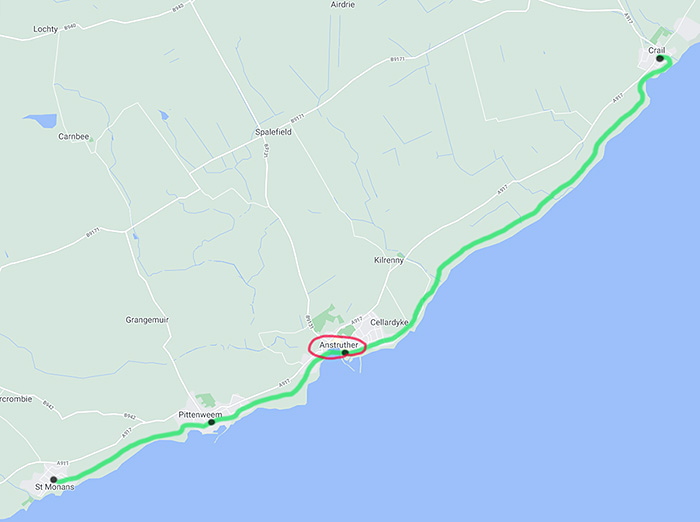
Our route Day Two & Three
Getting around:
We used Stagecoach bus. Two lines travel up and down the coast. Line 95 serves the northern half where we were hiking. Tickets for single rides cost £4 or day passes with unlimited rides under £9 pp.
DAY TWO: Crail to Anstruther ~ total 6 miles
We awoke well-rested in Elie. After breakfast, we checked out of the Ship Inn and dragged our luggage uphill to the bus stop. It was time for our next destination on the trail. We hopped on Stagecoach bus line 95 heading north, and rode 15 minutes to Anstruther. Every so often we saw part of the coast where we’d hiked yesterday.
With a population of 3,440, Anstruther is the largest in the string of five quaint fishing villages that comprise East Nuek. In the harbor, you can visit a fisheries museum, or depart on a five hour boat trip to the Isle of May. Shops selling bread, ice cream, coffee, gifts, flowers and home decor congregate around the harbor. But the most popular place tourists go is the Anstruther Fish Bar for “UK’s best fish ‘n chips.” Which was just down the street from our hostel.

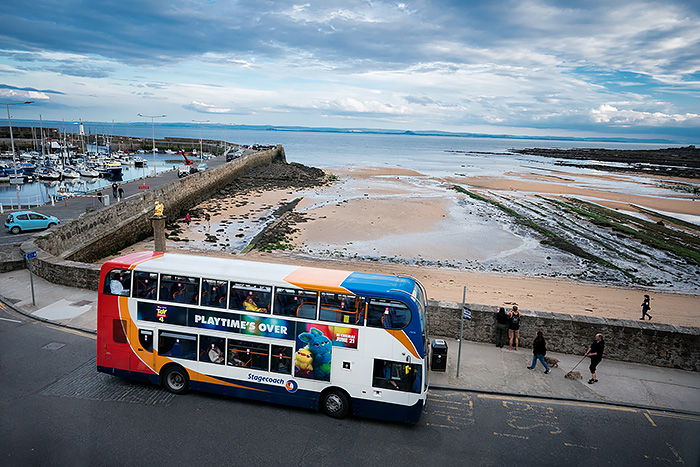
The bus dropped us off at the harbor, directly in front the Murray Library Hostel, where we’d be spending the next two nights. What a convenient spot for catching the bus!
Our Lodging on Scotland’s Fife Coastal Path

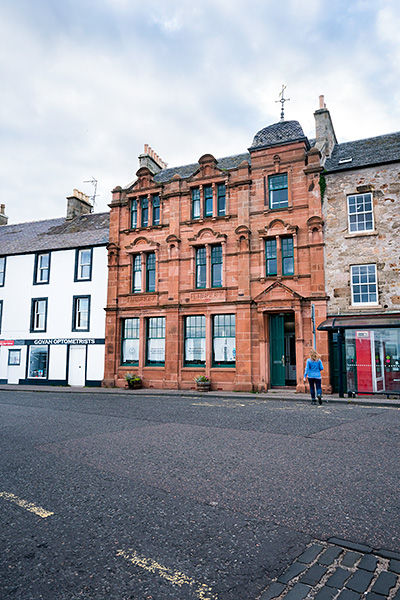
The Murray Library Hostel is a historic property that’s been converted into lodging. In addition to traditional 4 and 8 bed dorm rooms, there is family room and private rooms with twin/double beds. All are sea-facing rooms and have desks, wash basins and linens/towels. The community kitchen downstairs is bright and airy (currently closed during Covid) next to a lounge with tv, piano and bookshelves—it is a library after all!. Rates are around £110.00 for a private room 2 night minimum stay.

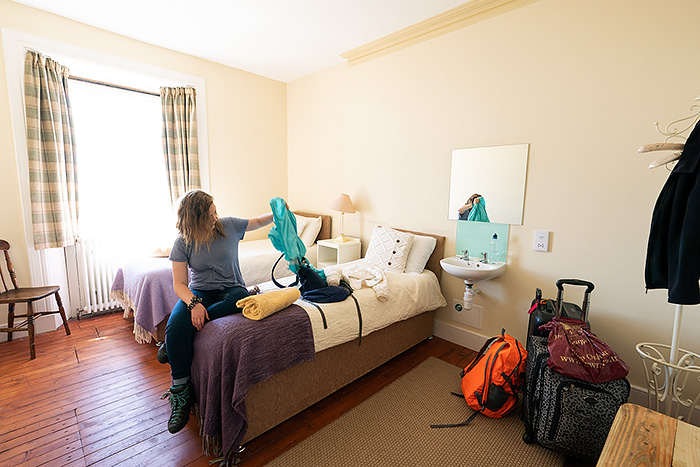
We settled in to our third floor room, which overlooked the harbor and Fife Coastal Path. Changing into our boots, we went down to catch the next bus for Crail. Our new plan —since we had trouble finding the bus yesterday—was to ride to the beginning of the trailhead and simply hike back to our inn. Lesson learned!
Crail Village
This tiny village may look half-abandoned now, but it once had important royal ties. Way back in 1178, King William the Lyon proclaimed Crail a Royal Burgh and built a castle here. He opened up trading and selling in 3 marketplaces to collect levies and taxes. Fishermen caught herring and haddock and had up to 200 ships in the harbor. Today this sleepy village relies on crab and lobster fishing and tourism. There are numerous guesthouses here.
We wandered around the backstreets. The Tolbooth, a landmark dating from 1517, looms above an intersection where one early market took place. Tolbooths contained the court house, jail and place to pay taxes, levies and fines. Across the street was the Crail Heritage museum. The volunteers were just locking up when we arrived. So we didn’t get to see the exhibits about the royal past or the WWII naval torpedo training program.
Heading toward the harbor, we stopped in at Crail Pottery & the Beehive shop. Then found a place for lunch…

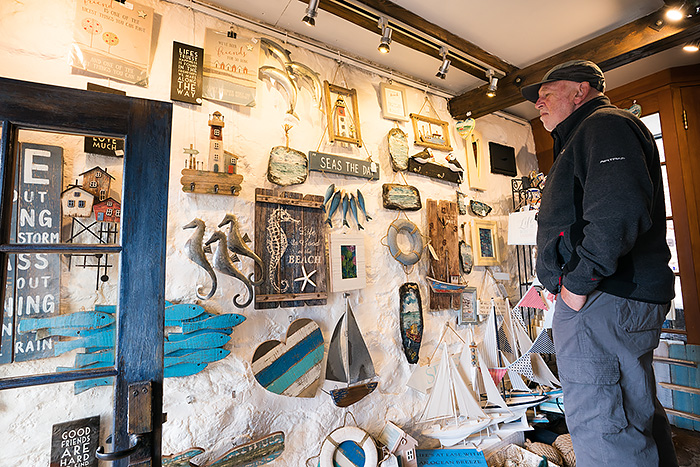
We had soup and scones at Crail Harbor Gallery & Tearoom, a cute place with lots of sea-related gift items. And tempting sponge cakes and fruit tarts under glass.

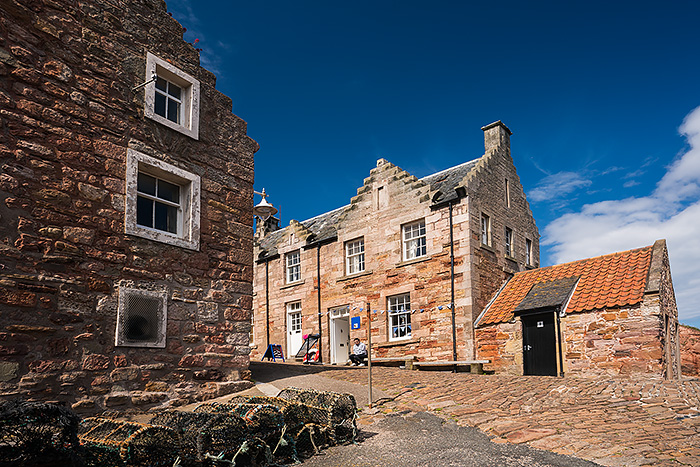 Crail harbor
Crail harbor

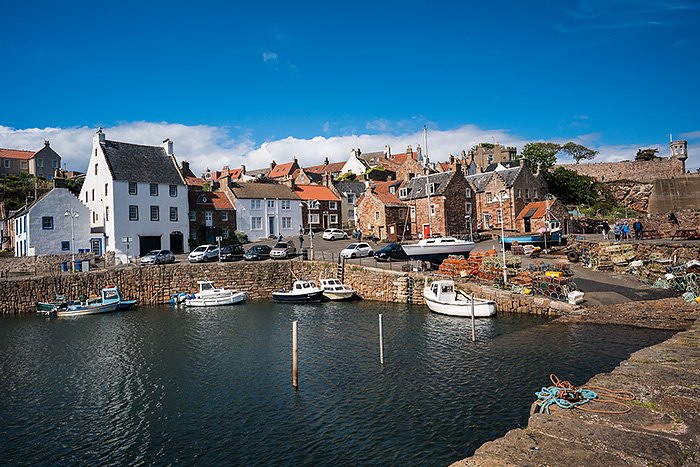
Hiking Crail to Anstruther: 4.5 miles
Around 3:30pm, it was finally time to hike! We left the harbor and headed south. About 10 minutes later, we saw this overview of Crail when we looked back.

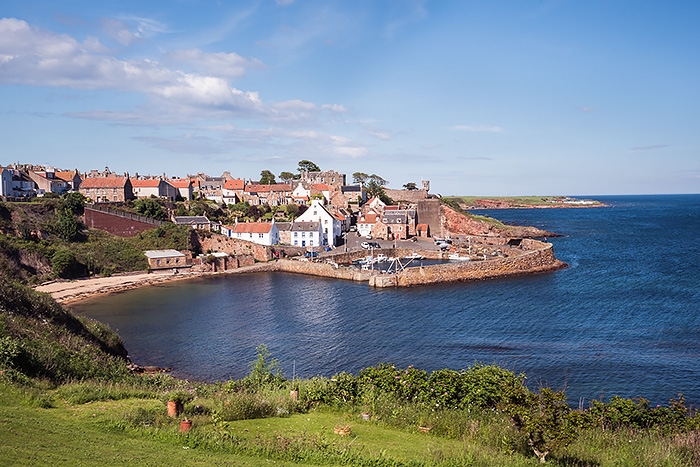
Pretty soon we came to a stone wall and stepped across the stile in a pasture with livestock.


Caiplie Caves
Two miles into our hike we came to the Caiplie Caves. This rather strange sandstone outcropping stands on the side of the Fife Coastal path. Wind eroded arches and narrow openings enticed us to wander.

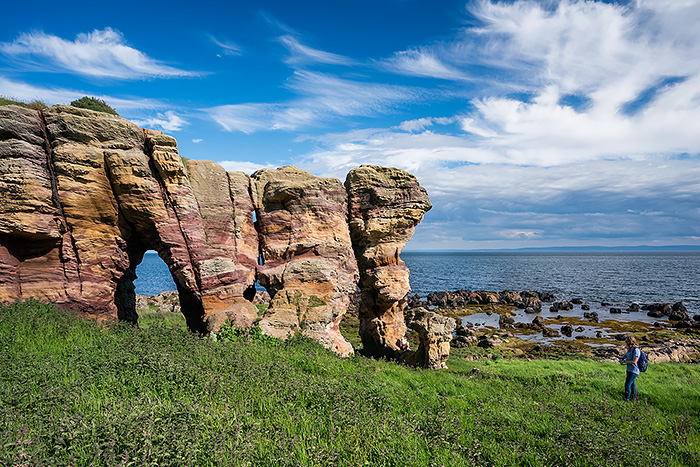 Early Christian crosses and graffiti decorate the walls inside these rock formations.
Early Christian crosses and graffiti decorate the walls inside these rock formations.

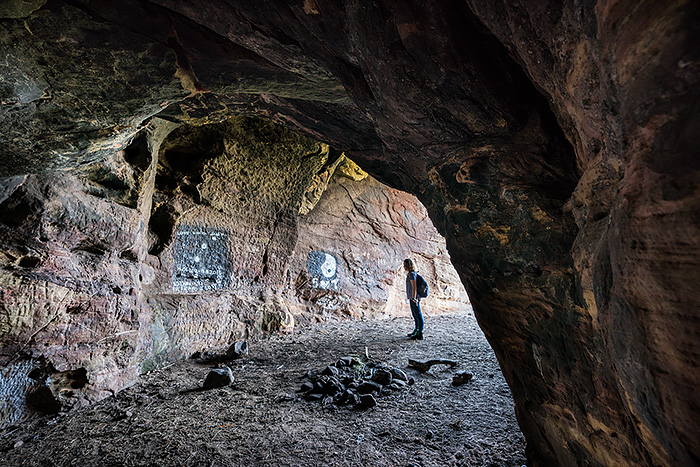 Not sure why they’re called caves though–more like passageways to the other side.
Not sure why they’re called caves though–more like passageways to the other side.

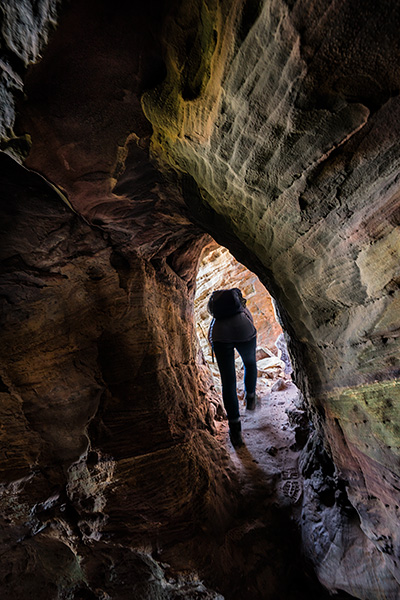
The next couple of miles took us on a path between a grassy field and the North Sea.
Cellardyke harbour
This little harbour came as a surprise. How charming! I had to know more. So I searched and found these bits of trivia…

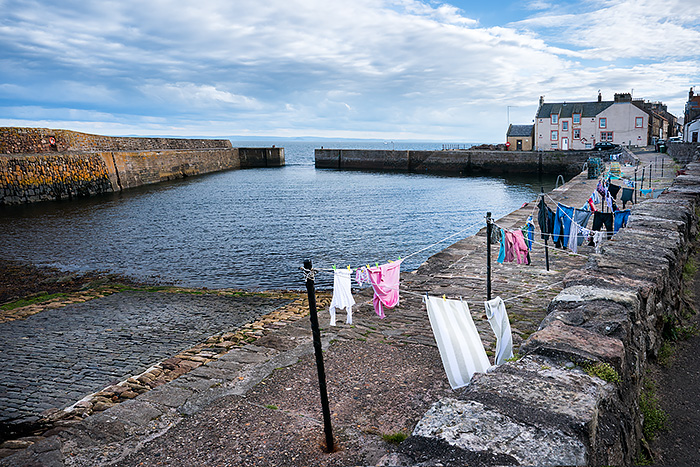
In 1578 this harbor was called Skynfast Haven. The name “Sil’erdykes” came from the shine of herring scales caught in nets hanging over walls (or dykes) to dry in the sun. Local residents were known as Dykers. This tiny harbor has a single narrow opening. Hard to imagine it full of boats, but at one time this was Scotland’s 2nd most important port! The customs collector in Anstruther reported 500 boats per summer bringing in large quantities of cod and haddock during the 1700’s.
In 1898, a storm damaged the harbour and the fishing fleets moved half a mile down the coast to Anstruther’s protected harbour. No wonder it looks empty now.

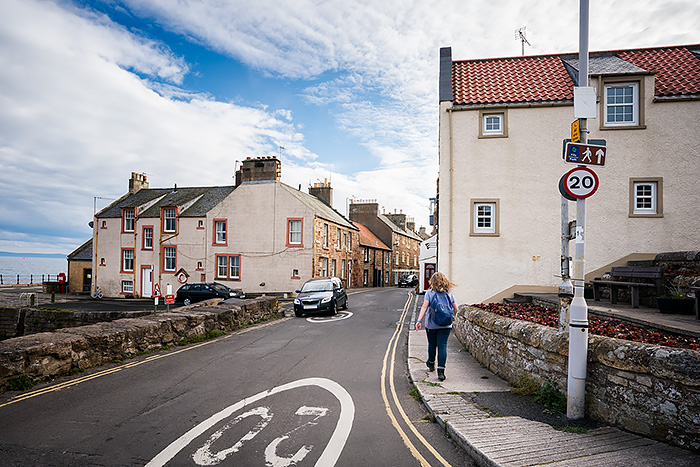
We followed the Fife Coastal Path down a narrow street filled with back-to-back fishing cottages through Cellardyke. Note trail signage on the street pole.

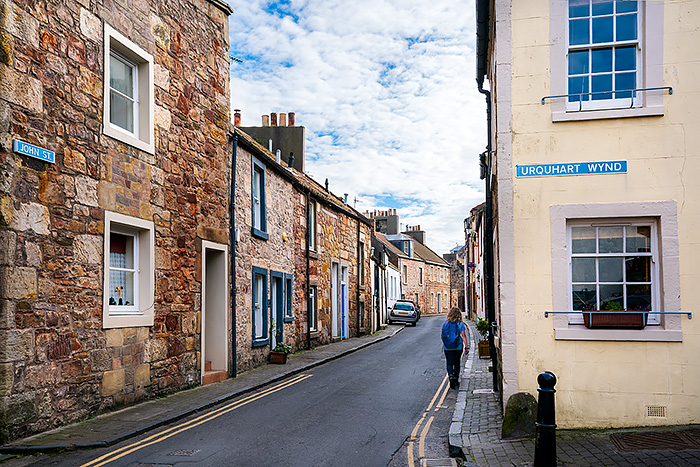
And soon arrived along the harbor in Anstruther. Although if you didn’t know any better, the seamless stretch of homes blends in as an extension of Anstruther village.
Fish ‘n Chips

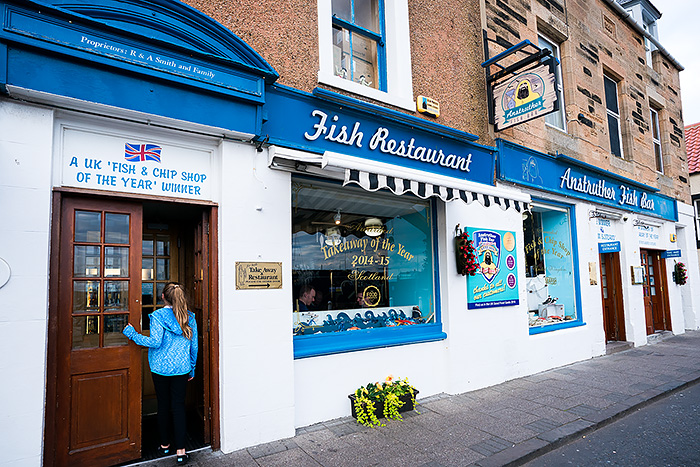
Of course we ate here! UK’s best…how could we not? Standing in a long line, we read newspaper clippings about their awards and saw photos of celebrities like Tom Hanks who’ve eaten here before us. The dining room was packed with no place to sit. So we took our fish boxes back to the hostel and ate in the large airy kitchen. Glad we had a sink nearby for our messy greasy fingers!
DAY THREE: St. Monans to Pittenweem to Anstruther ~ 4 miles
This morning we backtracked to St. Monans by bus. We had hiked to this village from Elie on day one, but now it was time to pick up where we left off and hike our way north to Anstruther.
(Have I mentioned just how convenient it was to stay within view of the bus stop? Knowing it came by every 30 minutes, we could be in our room, then FLY down the stairs when we heard it approach and still have plenty of time to catch the bus!)
Once in St. Monans, we followed the Fife Coastal Path signs out of the village and walked along the clear wide trail heading north along the shore. It was mid-June, and wildflowers were in full bloom. Temp was warm and hiking in a short sleeve shirt felt comfortable.

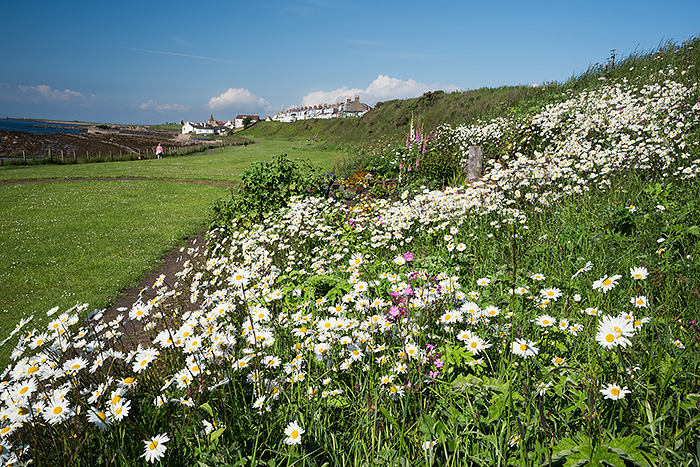
St. Monan’s village in distance, Scotland’s Fife Coastal Path
St. Monans Windmill
A half mile later we saw the old stone windmill sitting on a small hill. In the 18th century, nine salt pans were built on the beach for salt mining. And the windmill was built to pump sea water into the salt pans. When water evaporated, the salt was extracted and shipped by train to Pittenweem, the next village north. Salt mining here continued until 1820. Tourists that are curious to see the windmill can ask for a key in St. Monans before hiking out here at the Spar shop.

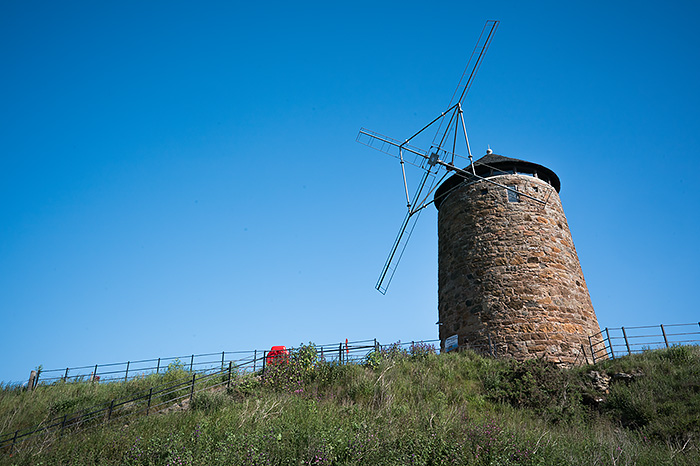
The salt pans dating from the 18th century were hard to interpret. They looked more like iron tinged rocks. The best view is reportedly from the top of the windmill.

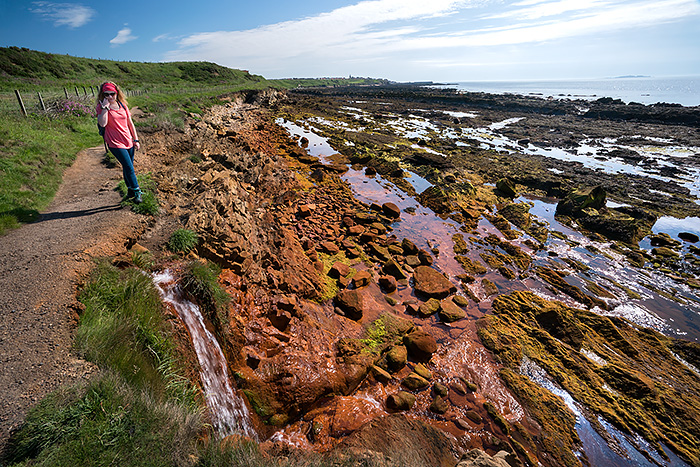
Other than the windmill and salt pans, there were no other sites or diversions on this 2 mile section of the trail between St. Monans and the even tinier village of Pittenweem.
Pittenweem
It even sounds tiny, doesn’t it? The name means “place of the cave” and refers to the 7th century missionary, St. Fillan. According to legend his left arm “glowed,” allowing him to read and write in the dark surrounds of the cave where he lived in this village. Many monks moved here in the 14th century in a Priory, which is long gone. St. Fillan’s cave, however, can still be seen if you only know who to ask!
Like Crail, this village became a royal bough in 1541, giving it the right to have markets, charge customs on goods and trade internationally. In 1575, it ranked with Crail as Scotland’s 12th richest town due to salt mining. Which is pretty hard to imagine now!
Another hard to believe fact inolved witchcraft. In 1705, the town believed the false accusations of 16 year-old Patrick, a blacksmith’s son who claimed people were sending bad thoughts his way. Based on his word alone, the town mob tortured, starved or killed 9 law-abiding “witches.” And when Patrick was exposed for being a complete liar, they let him go, Scot-free. Local Lenny Low’s book, The Weem Witch, is a fascinating, if not horrifying, read.
The Fife Coastal Path enters Pittenweem village near a shoreline park, where we saw a few moms and their kids playing. Soon after is the harbor lined by red-roofed white painted cottages–the largest belonging to sea captains.
From here we walked left on Water Mynd to reach the center. Time for tea! Peeking in the windows, we chose the bright and happy vibes of a tea shop that displayed colorful seaside painted plates and saucers for sale. Warm homemade scones with jam and tea was a perfect pick-me-up along the trail.

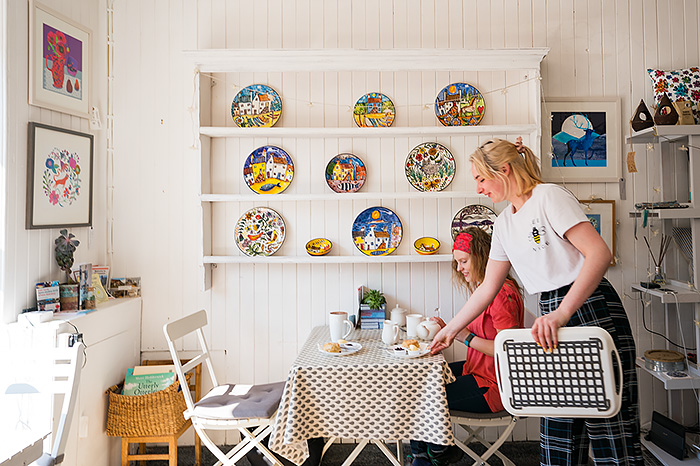
Tea and warm scones, anyone?
Wandering along the narrow street we looked for the Cocoa Tree Shop. Not necessarily to buy decadent chocolates, but rather to ask for a mysterious key! Paying a couple pounds for the priviledge, we took the key and followed directions to the cave…
St. Fillan’s Cave

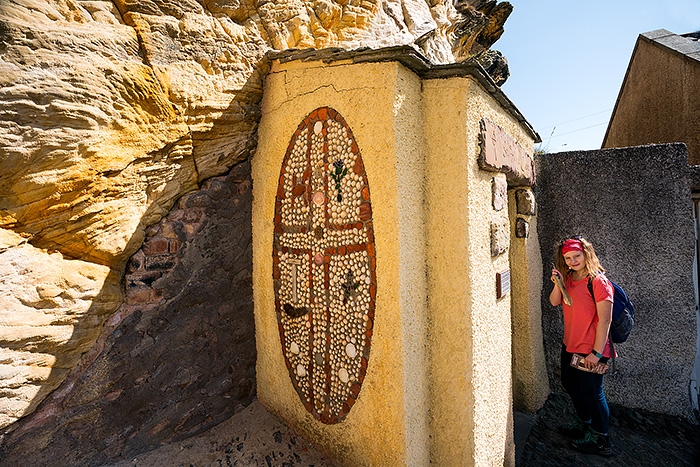
Unlocking the door to the past…

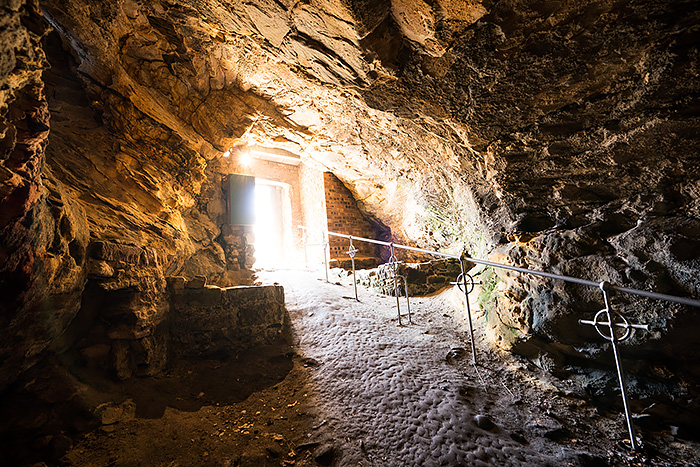

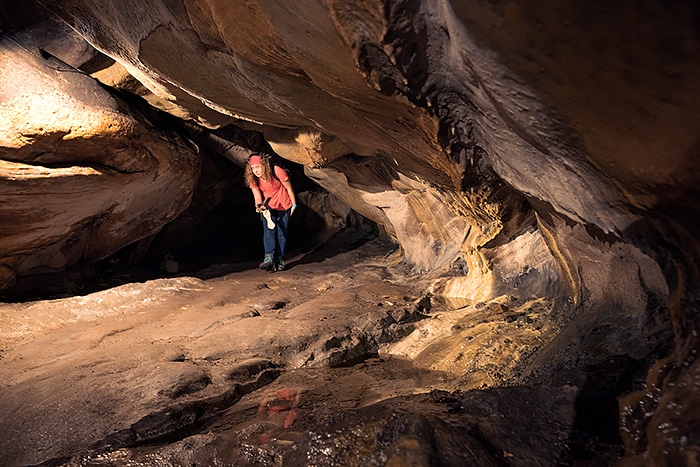
Tucking between rocky crevices, we poked around the nooks and crannies of the cave. We saw a shell embellished memorial and ascended a spooky narrow stairway that led nowhere. According to histoical records, fishermen inhabited this cave most recently. Prior to that, it is believed that monks making a pilgrimage here from Ireland & Spain also may have lived here, according to records and evidence in the area cemetery.
Hiking to Anstruther
Retracting our route to the harbor, we continued on to Anstruther through a little gap in the wall. We passed a golf course stretching toward the shore, and in a mile reached Anstruther harbor. Along the way be discussed how to spend the rest of the day. Initially, we had planned on visiting a cheesesmaking shop for lunch and then visiting the Secret Bunker— a HUGE 24,000 sq ft double layered underground command center built in 1953 during the threat of nuclear war with USSR—that laid hidden from the public for 40 years.
But both of these sights were located six miles away in the country. Since buses only traveled the coastal route between villages, and taxis had to be reserved far in advance (there are only 3 companies between St. Andrews and Elie) we had no way to get there! (Uber doesn’t exist here yet either.)
So what else should we do? We could pick a different section of the trail to hike. Or…what about a trip to Dundee? We could visit Shackleton’s fomous ship, walk around town and maybe catch a movie? Checking the Stagecoach bus schedule, we saw it was possible. If we caught Line 95 in front of our hostel, then change to Line 99 in St. Andrews we’d get there in an hour. Wanna go? Heck, yeah!
Dundee… our diversion OFF trail! ~ 5 miles


Transportation
Dundee is across the river from the end of Scotland’s Fife Coastal Path. Located 14 miles north of St. Andrews, travel from Anstruther to Dundee by bus was easy, with a short connection.
The hard part was finding the bus to come home waaay later that night. We kept walking to different bus stops, but none of them listed Line 99 or 95 heading south. Even the locals steered us the wrong way. After 4 failed attempts, we walked all the way back across town to the main bus station. No staff were present, but a cleaning lady saved the day. She led us outside and showed us where to wait for the next bus.
In St. Andrews, we had a 50 minute wait for our connecting next bus (frustrating since we were only 10 miles from our hostel in Anstruther). But. We could’ve been stranded in Dundee as this was the last bus of the day. We arrived home at 11:30pm.
Wandering Around
Jordan did a quick search on Instagram to see what was trending in Dundee. Minutes later we were on a scavenger hunt to find a particular bakery…

.jpg)
Success! We found the rainbow bagels.
Contrasting Ships in Discovery Point
Walking down to the harbor, we found the two major sights of Dundee. The sleek contemporary steel and glass V&A ‘ship’ sits next to the historic wooden three-masted RRS Discovery ship that carried Scott & Shackleton to Antarctia in 1910. We visited both.

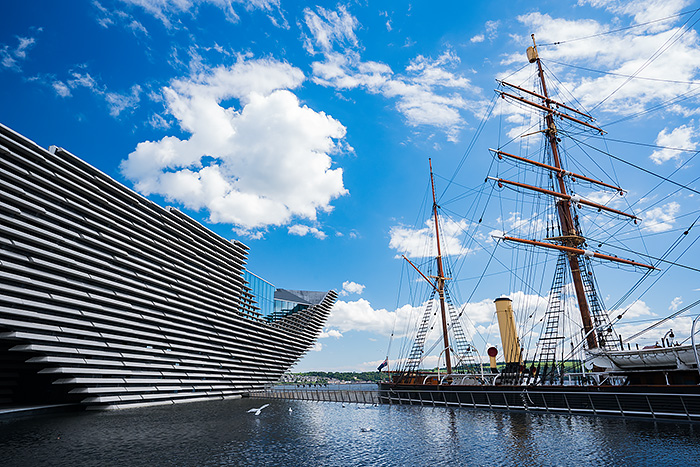
Love the juxtaposition!

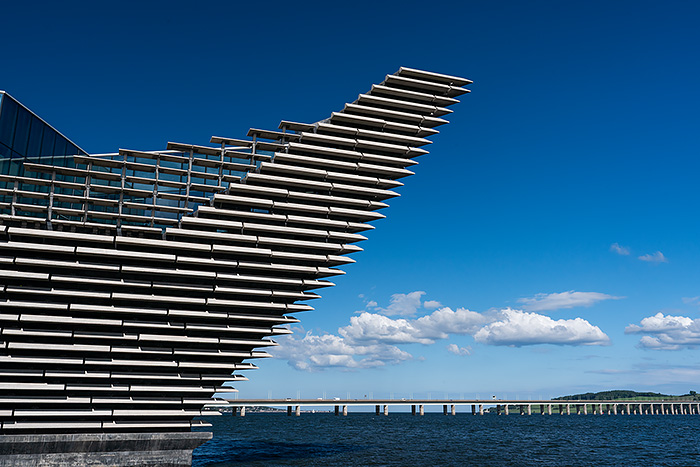 V&A Dundee
V&A Dundee
The V&A Dundee design museum, designed by Kengo Kuma, opened in 2018. The glass and steel exterior mimics a giant ship. The interior is spacious and open. Stairs from the cafe lead up to the second level where there’s a permanent exhibit about Scottish design, a rotating exhibit (£9) and empty office rooms. We breezed through the permanent exhibit in about 15 minutes. To be fair we skipped the rotating exhibit about video games, but to me, the striking architecture far outshined the art exhibits in the V&A Dundee.

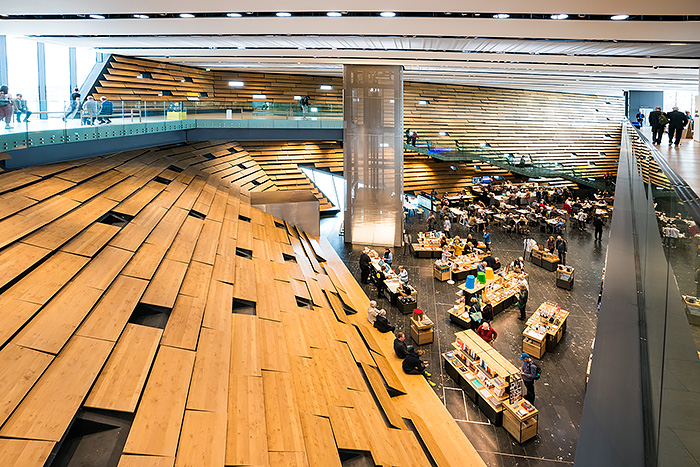
View of cafe on ground floor

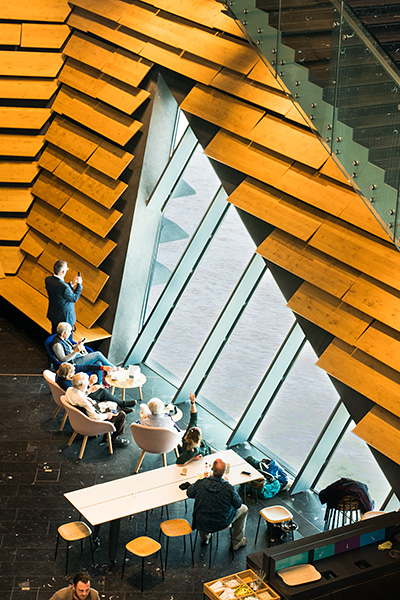
RRS Discovery Ship
Inside the Discovery Museum, we sat on “ice cubes” watching a film about the harsh conditions and challenges during this famous Antarctic expedition. Then proceeded through the interactive exhibits, reading facts and listening to recorded stories about the discoveries, dangers, illnesses, leisure activities, food and life at sea. Absolutely fascinating!

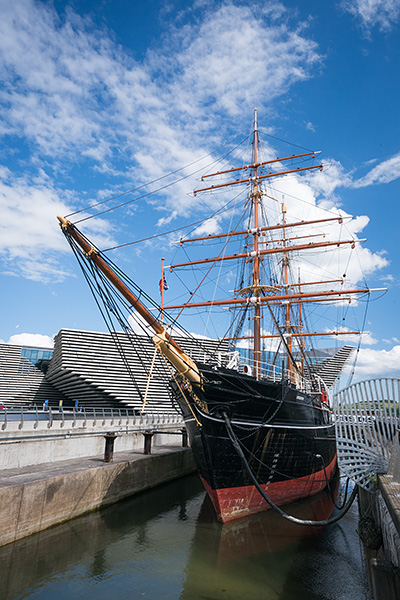 Stepping aboard the actual ship really made these stories come to life!
Stepping aboard the actual ship really made these stories come to life!

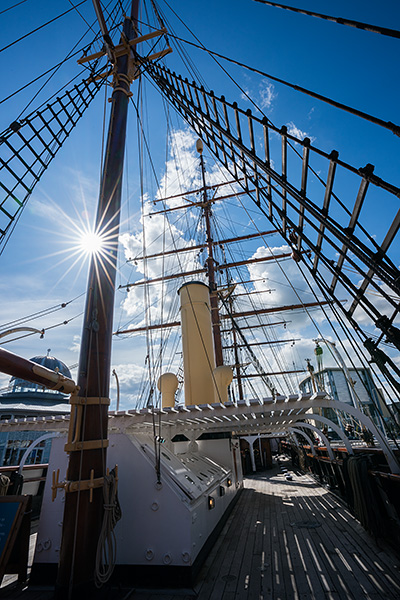 Descending to the lower deck, we saw the sailor’s living quarters, the strange coffin-like sick bay, kitchen, the large wooden dining table where many a conversation and planning occured.
Descending to the lower deck, we saw the sailor’s living quarters, the strange coffin-like sick bay, kitchen, the large wooden dining table where many a conversation and planning occured.

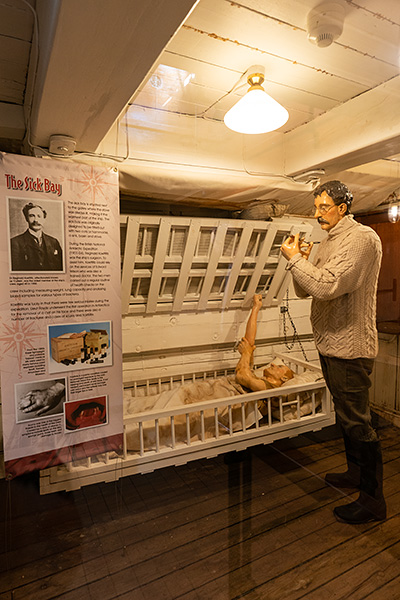
Sick bay

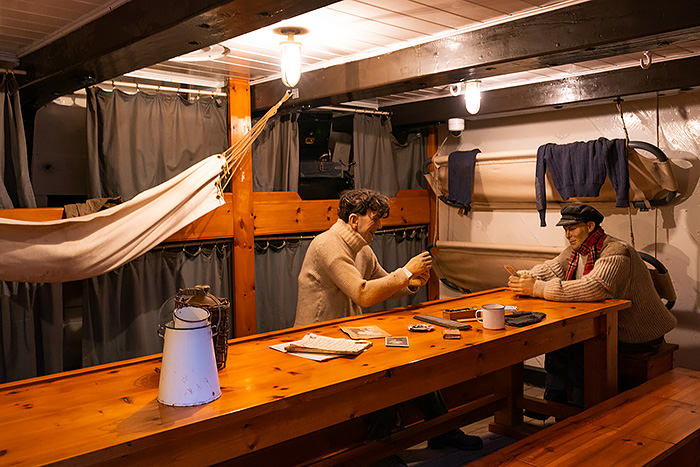 Captain Scott’s quarters
Captain Scott’s quarters

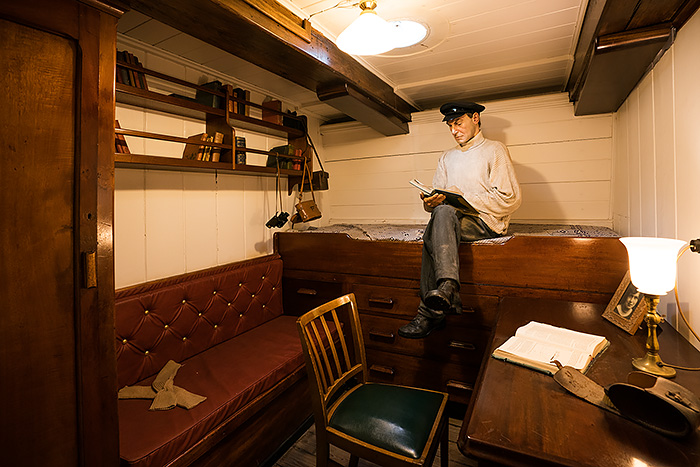
This ship, originally built in Dundee and beautifully restored, is one of only two ships that exist from this era of polar exploration. Well worth the time and admission.
Sculpture Art
Bronze statues of comic characters featured in The Beano and The Dandy cartoon are scattered around town to honor local Dundee cartoonist, DC Thomson.
We walked over five miles exploring the city, randomly checking out places that caught our eye. It was graduation weekend. College graduates in their cap and gown walked along the waterfront with their families posing for pics by the iconic sites. Later we took another bus west of town to catch dinner and a movie. And then began our frustrating hunt for the right bus to return home. Overall, a fun, full day!
Total walked: 9 miles
DAY FOUR St. Andrews ~ 11.5 miles
St. Andrews is a large and popular town directly on Scotland’s Fife Coastal path. Tourists flock to see the birthplace of golf, Scotland’s oldest university, and ruins from the bloody Reformation.
Located north of Anstruther, St. Andrews can be reached on a 13 mile hike on the Fife Coastal Path or a 10 mile bus ride. Planning to spend a full day and stay overnight, we rode the bus instead of hiking here. Yet still managed to log 11.5 miles just walking around the coast, sights, university campus, golf course and West Sand beach.
Lodging

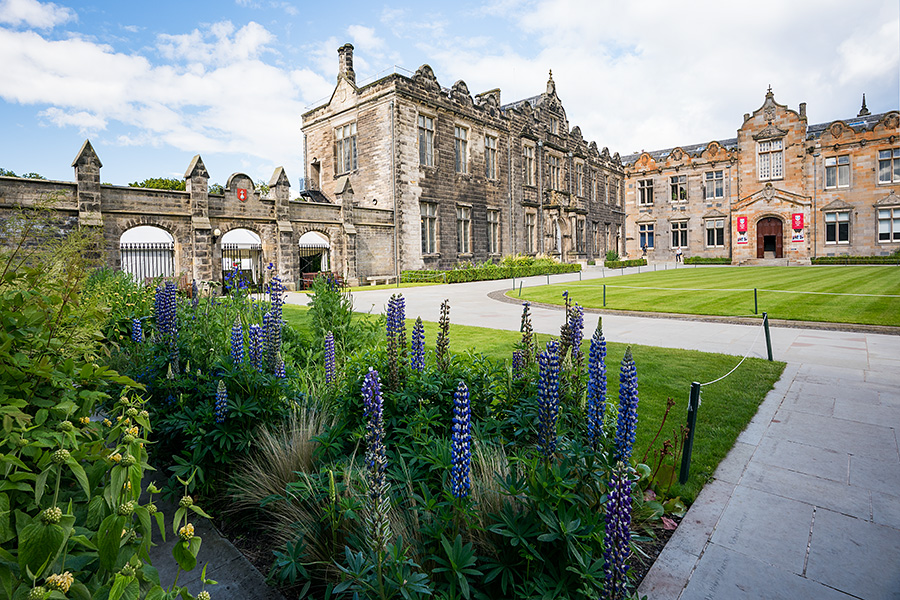
St. Andrews University campus dates from 1413
St. Andrews has plenty of lodging options from ritzy golf course hotels and beachside B&Bs to more humble abodes on the university (June to September).
How fitting that we could stay on campus! This was the summer before my daughter started college and moved into a dorm…so why not give her a glimpse into college living? The University of St. Andrews offers B&B accommodations in four different Halls. Private rooms have shared or ensuite baths. Breakfast–a massive feast– is with the students in the dining court.
We chose a twin room in Wardlow dorm in Univeristy Hall. Built in 1896, this adorable girls dorm resembles a castle.

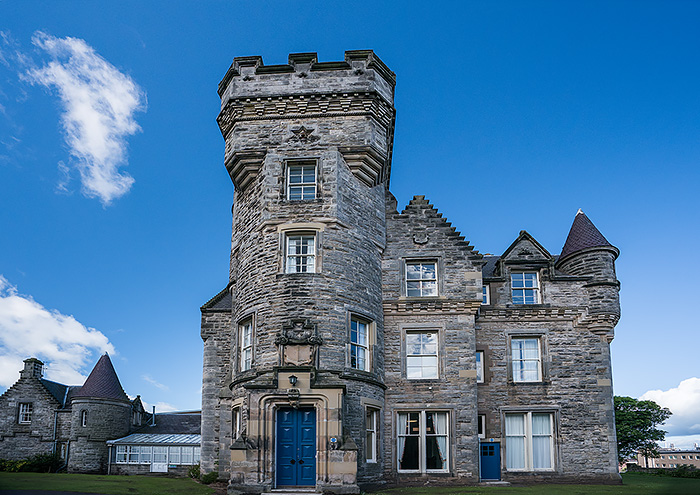 Look at our room! (Don’t expect this kind of space at Purdue!)
Look at our room! (Don’t expect this kind of space at Purdue!)

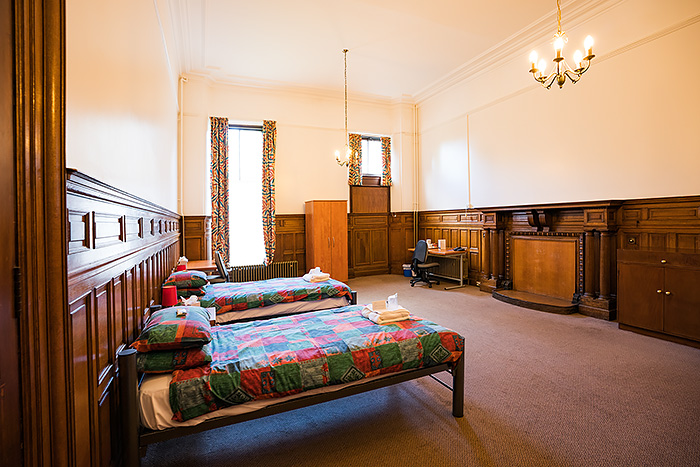 There were even chocolates on our pillows. Comfy beds, a spacious lounge and an excellent breakfast. Talk about a charming budget stay!
There were even chocolates on our pillows. Comfy beds, a spacious lounge and an excellent breakfast. Talk about a charming budget stay!

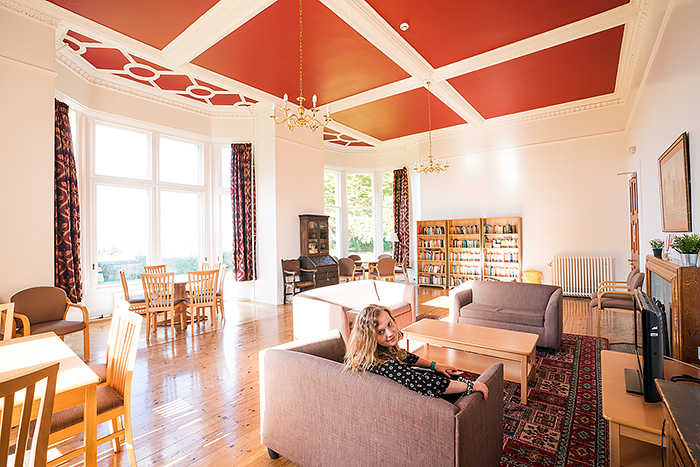
Our dorm room was a 15 minute walk west from the center of town.
Golfing

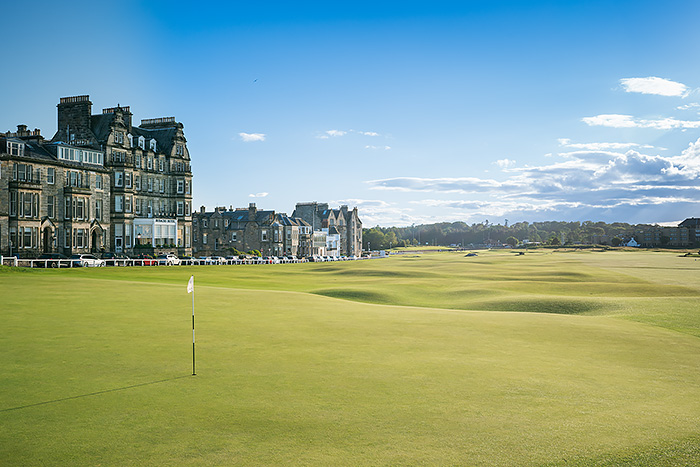
Playing on the Old Course is the huge draw. But there are 6 other golf courses if you can’t secure a spot. Golfers apply for tee times by booking online but can also win tee times through a lottery drawn 48 hours in advance.

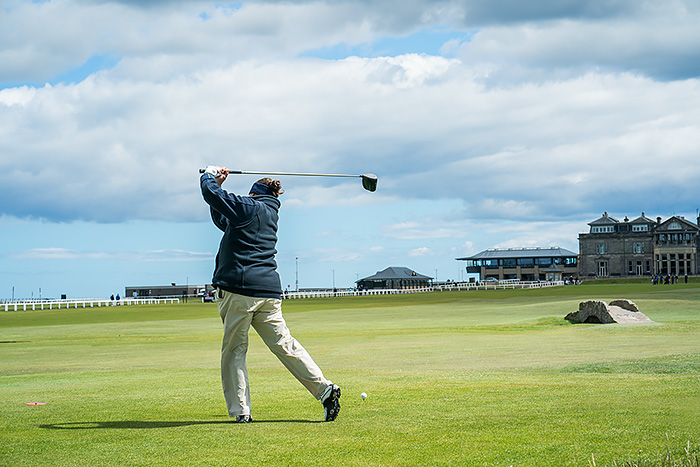
A golfer swings at the 18th hole ear the iconic Swilcan Bridge on the Old Course—where golf was first played 600 years ago! In the distant building you can eat breakfast or lunch in the glass encased dining room to watch the golfers. Jordan and I ate breakfast here when we arrived in St. Andrews and can attest for being a great spot! The golf museum is the building to the right.
Until we visited the British Golf Museum, I never knew that early golf balls were made out of feathers. Did you?

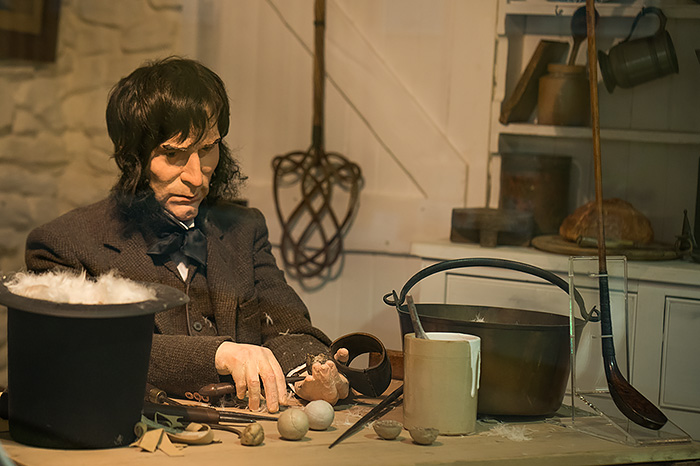
St. Andrews Castle
Part Bishop’s palace. Part fortress. Watch a short film to understand the history of St. Andrew’s Castle before exploring the ruins. Crawl through the eerie countermine tunnel, peer into the dungeon, and walk around the tower and fragmented ruins sitting on a grassy bank overlooking the North Sea.

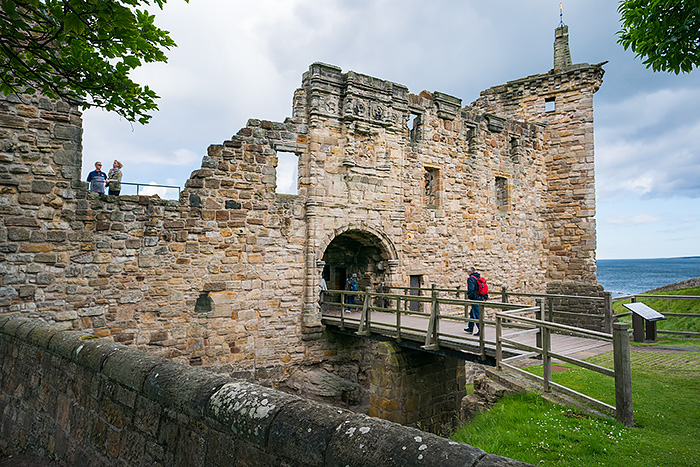
Unlike other castles, this one was inhabited by religious rulers, not kings. Beginnning in 1189, a line of wealthy powerful bishops occupied the castle during the time when St. Andrews served as the ecclesiastical center of Scotland. But during the Protestant Reformation, the castle became the site of torture, death and persecution as the Bishops led bloody attacks on English Protestants.

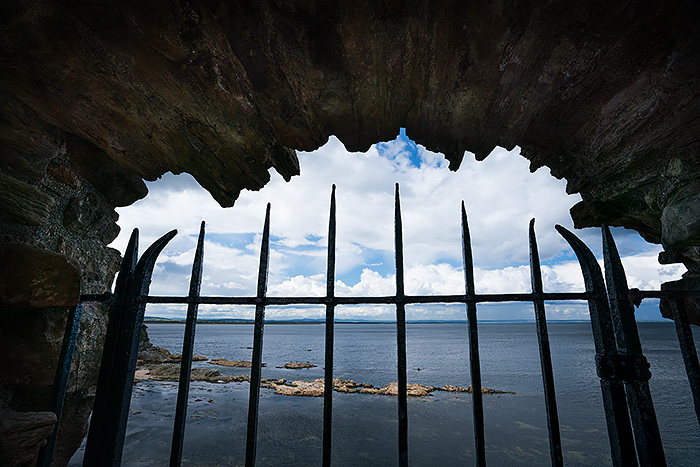
The gruesome history of this castle plays out like a violent movie…

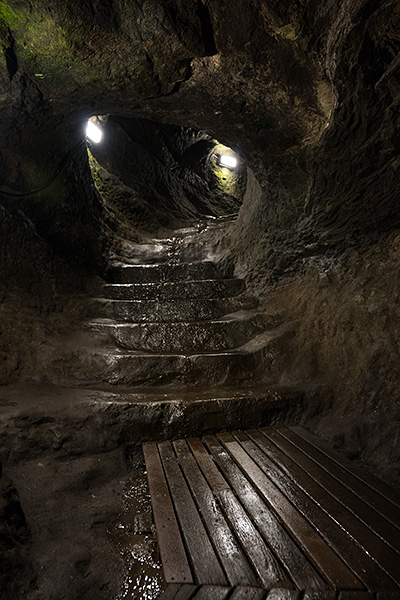
Tunnel dug to defend and attack in 1546
Cardinal Beaton imprisoned Protestant preacher George Wishard in the Sea Tower 1546 before burning him alive at the stake. In retaliation, George’s followers dressed up as masons and entered the castle walls where they murdered the Cardinal and swung his body from a window before stuffing him in the dungeon. During a short peaceful Protestant rule, attackers seized the castle and imprisoned John Knox. Archbishops took over once again and ruled until 1689 when Parliment finally separated bishops from the castle. And it slowly deteriorated into ruins.

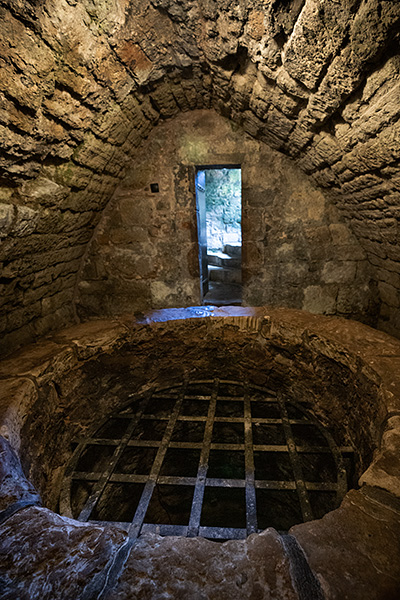
Bottle dungeon where prisoners starved to death
St. Andrews Cathedral


Dating from 1158, this medieval Cathedral was once the most magnificent Catholic church in all of Scotland. It was the headquarters for leading bishops and archbishops until 1560. When mass was outlawed during the Reformation, a mob of angry Protestants– fired up by John Knox’s preaching– attacked the church. It slowly fell into ruin.

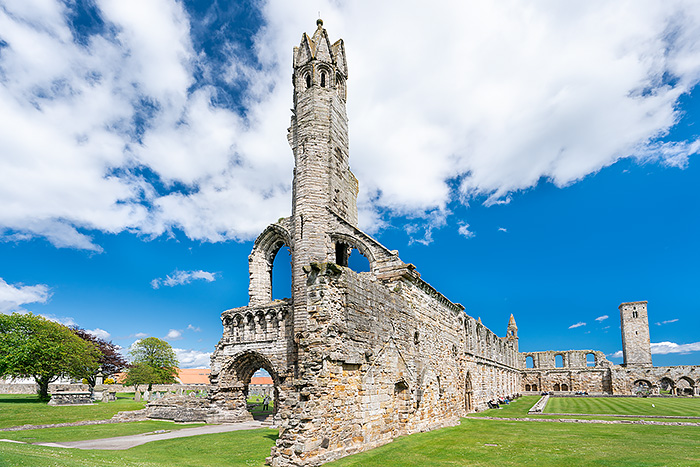
The prominent tower served as a beacon leading pilgrims and worshippers here as far back as 700 AD, when St. Rule brought the relics of Apostle Andrew from Greece.

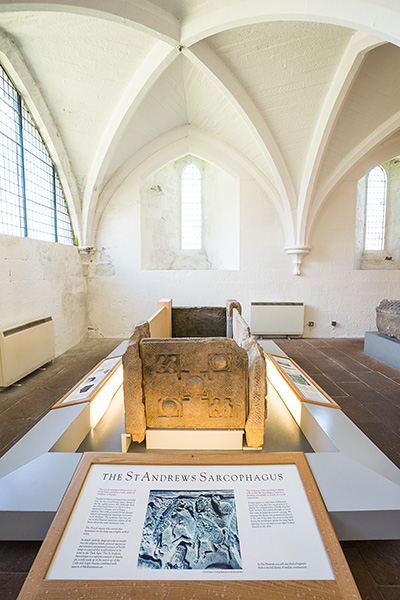
Relics of Apostle Andrew
St. Rule’s Tower sits behind the Cathedral in a cemetery on the enclosed property. You can climb the tower for impressive panoramic views. And see part of the Fife Coastal Path.

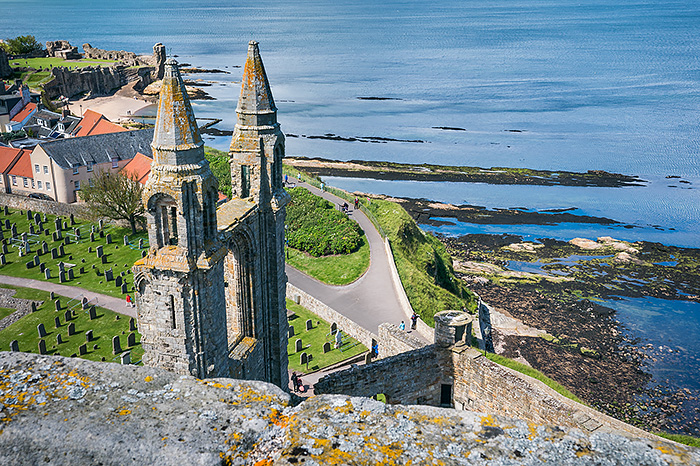
St. Andrews on Scotland’s Fife Coastal Path
Shopping & Eating

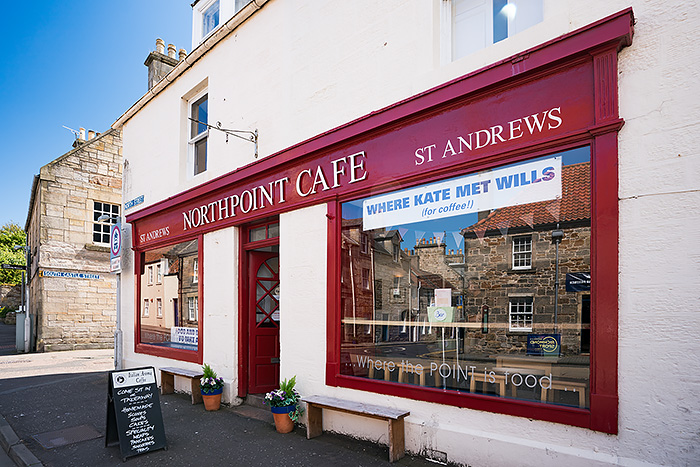
Prince William & Kate’s favorite hangout
St. Andrews has a variety of places to eat from pub fare to Indian curries spread over three streets. Of course we had to dine where the Prince met Kate for coffee while university students here. We later enjoyed traditional Scottish food in a busy pub filled with locals.
West Sands Beach

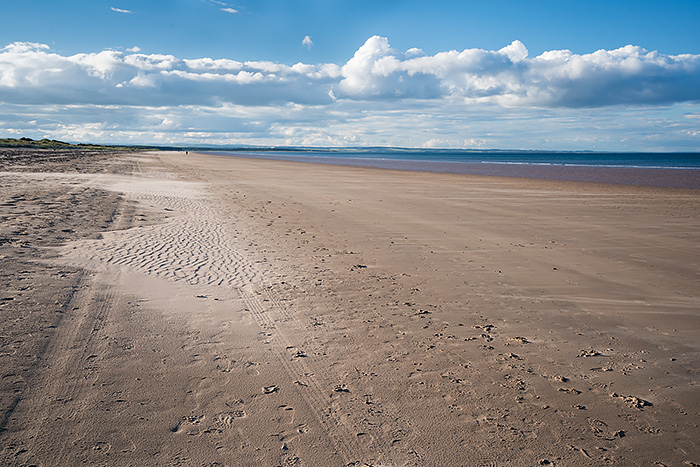
If you’re old enough, you’ll remember the movie Chariots of Fire. The sloooow motion running scene was filmed on this beach. (My daughter had no frame of reference, but was game to act it out!)
Windsurfing is an activity that we’d hoped to try. Blown Away offers guided instruction to go land yachting–a sport that combines sailing with motor racing. Sitting in a small three-wheeled frame you learn to manipulate your sail across the sand when winds pick up speed. We walked down this beach expecting to find them but…never did.
We were pretty exhausted anyway. Another full day! Our overnight in the charming Wardlow castle was the perfect conclusion to our stay in the Kingdom of Fife.
Impressions of Scotland’s Fife Coastal Path
Of the 117 miles stretching along this long distance trail, Jordan and I only hiked a small portion. But what we did hike, we liked. The path was fairly flat and easy to follow with clear signage. We rarely saw another soul on the trail even though it was mid-June and pre-Covid. I loved the short distances between villages which allowed ample time for exploring & diversions.
Hiking a few sections of Scotland’s Fife Coastal Path allowed us to see a different side of Scotland, away from crowds or even other tourists (apart from St. Andrews). Having the option to travel by bus to the beginning of the trailhead was efficient and easy. Leapfrogging and staying in different villages along the trail was an intergral part of the experience and we wouldn’t do it any other way. Highly recommend it!
Tips: Read this guidebook to help narrow down which sections to hike, then decide where to stay. See this post for more planning tips to customize your own trip.


